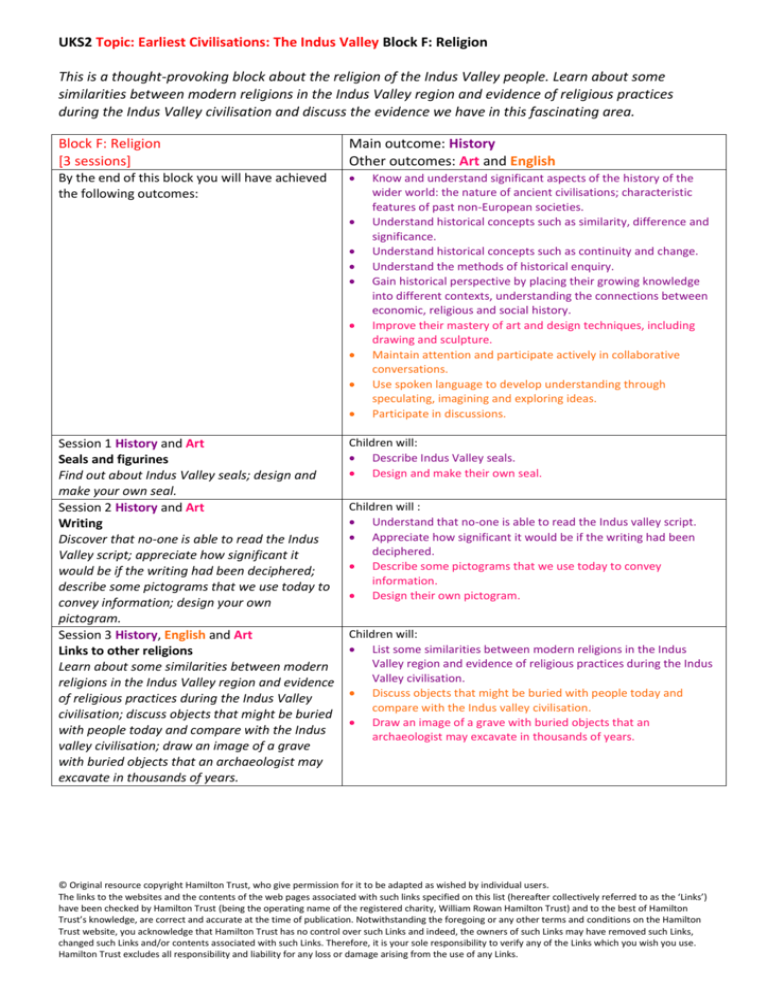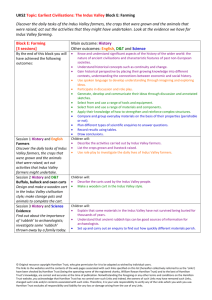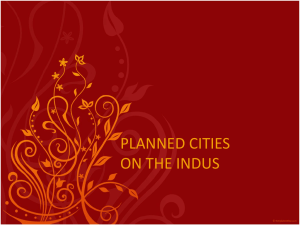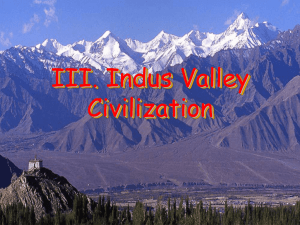Block Outcomes - Hamilton Trust
advertisement

UKS2 Topic: Earliest Civilisations: The Indus Valley Block F: Religion This is a thought-provoking block about the religion of the Indus Valley people. Learn about some similarities between modern religions in the Indus Valley region and evidence of religious practices during the Indus Valley civilisation and discuss the evidence we have in this fascinating area. Block F: Religion [3 sessions] Main outcome: History Other outcomes: Art and English By the end of this block you will have achieved the following outcomes: Session 1 History and Art Seals and figurines Find out about Indus Valley seals; design and make your own seal. Session 2 History and Art Writing Discover that no-one is able to read the Indus Valley script; appreciate how significant it would be if the writing had been deciphered; describe some pictograms that we use today to convey information; design your own pictogram. Session 3 History, English and Art Links to other religions Learn about some similarities between modern religions in the Indus Valley region and evidence of religious practices during the Indus Valley civilisation; discuss objects that might be buried with people today and compare with the Indus valley civilisation; draw an image of a grave with buried objects that an archaeologist may excavate in thousands of years. Know and understand significant aspects of the history of the wider world: the nature of ancient civilisations; characteristic features of past non-European societies. Understand historical concepts such as similarity, difference and significance. Understand historical concepts such as continuity and change. Understand the methods of historical enquiry. Gain historical perspective by placing their growing knowledge into different contexts, understanding the connections between economic, religious and social history. Improve their mastery of art and design techniques, including drawing and sculpture. Maintain attention and participate actively in collaborative conversations. Use spoken language to develop understanding through speculating, imagining and exploring ideas. Participate in discussions. Children will: Describe Indus Valley seals. Design and make their own seal. Children will : Understand that no-one is able to read the Indus valley script. Appreciate how significant it would be if the writing had been deciphered. Describe some pictograms that we use today to convey information. Design their own pictogram. Children will: List some similarities between modern religions in the Indus Valley region and evidence of religious practices during the Indus Valley civilisation. Discuss objects that might be buried with people today and compare with the Indus valley civilisation. Draw an image of a grave with buried objects that an archaeologist may excavate in thousands of years. © Original resource copyright Hamilton Trust, who give permission for it to be adapted as wished by individual users. The links to the websites and the contents of the web pages associated with such links specified on this list (hereafter collectively referred to as the ‘Links’) have been checked by Hamilton Trust (being the operating name of the registered charity, William Rowan Hamilton Trust) and to the best of Hamilton Trust’s knowledge, are correct and accurate at the time of publication. Notwithstanding the foregoing or any other terms and conditions on the Hamilton Trust website, you acknowledge that Hamilton Trust has no control over such Links and indeed, the owners of such Links may have removed such Links, changed such Links and/or contents associated with such Links. Therefore, it is your sole responsibility to verify any of the Links which you wish you use. Hamilton Trust excludes all responsibility and liability for any loss or damage arising from the use of any Links. UKS2 Topic: Earliest Civilisations: The Indus Valley Block F: Religion Resources Session 1 Provided: Images of Indus artefacts; Playdough instructions. You will need: Air-dried clay; Clay modelling tools; Plasticine or playdough (make your own – see session resources!); Computer/laptop for each pair of chn. Session 2 Provided: Pictograms used today, Indus Valley pictograms; Pictogram template. You will need: Access to computer/laptop for each pair of chn; Pencils; Rulers; Black felt tips or paint & brushes. Session 3 Provided: You will need: Drawing pencils and paper. © Original resource copyright Hamilton Trust, who give permission for it to be adapted as wished by individual users. The links to the websites and the contents of the web pages associated with such links specified on this list (hereafter collectively referred to as the ‘Links’) have been checked by Hamilton Trust (being the operating name of the registered charity, William Rowan Hamilton Trust) and to the best of Hamilton Trust’s knowledge, are correct and accurate at the time of publication. Notwithstanding the foregoing or any other terms and conditions on the Hamilton Trust website, you acknowledge that Hamilton Trust has no control over such Links and indeed, the owners of such Links may have removed such Links, changed such Links and/or contents associated with such Links. Therefore, it is your sole responsibility to verify any of the Links which you wish you use. Hamilton Trust excludes all responsibility and liability for any loss or damage arising from the use of any Links.



![Indus[1] - ridgeaphistory](http://s3.studylib.net/store/data/006736077_1-c59280ecd30594bac8ab21ec7bce4db4-300x300.png)




